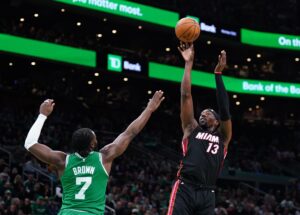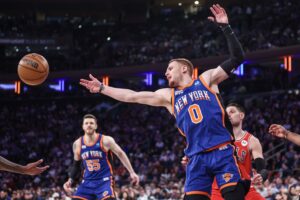From “one-and-done” prospects to the record-low number of seniors in the NBA draft, basketball has increasingly become fixated on youth. However, while they may not be flashy five-star recruits, college basketball transfers have consistently proven that they can play important roles on contending NCAA teams. One player who could fit this mold is DePaul combo guard Javon Freeman-Liberty.
Javon Freeman-Liberty Breakdown
Note: The former Valparaiso guard is waiting for an NCAA decision on his immediate eligibility waiver. Consequently, Freeman-Liberty may not be eligible to play this season. Nonetheless, he seems to be in a position to play this season.
Offense
Javon Freeman-Liberty’s calling card is his explosiveness. He can break down defenses by driving into the lane against bigger defenders, which is a big reason that he’s labeled as a “high-motor” player on offense. Despite being only 6’3, he had 16 dunks, 116 “close 2” field goals, and a remarkable 17.2 defensive rebounding percentage. While his passing needs more improvement, he showed an ability to thread the needle and deliver dimes to awaiting big men in traffic, and he posted a solid 21.7 assist percentage. The only players in the last decade to match these benchmarks of size, explosiveness and passing are Portland Trailblazers guard CJ McCollum and Washington Wizards guard Gary Payton II. That’s some pretty nice company, especially for someone who isn’t really projected to be drafted as of now. Note that McCollum and Payton were also high-usage, athletic guards for lesser-known programs. Both were also older prospects.
One thing that Freeman-Liberty could improve on is becoming a more effective passer as a point-of-attack penetrator. Everyone knows that he’s a solid finisher who can drive to the paint in isolation situations. However, he hasn’t really shown an ability to kick out to shooters on the wing. Part of the reason he didn’t do this was that the big men in the MVC aren’t particularly good rim-protectors, and also Valparaiso didn’t exhibit much consistent three-point shooting. While DePaul doesn’t necessarily have the next Sam Hauser, Freeman-Liberty is going to have to distribute the rock more effectively to the players around him. This will help prove that he can thrive as a playmaker at the NBA level.
Defense
One concern with many mid-major guards is their build. Whether it’s athleticism, height, or frame, scouts are often worried about how such players will adapt to increased levels of competition. The same applies to Freeman-Liberty. Though he is certainly athletic, he is only 6’3 and 175 pounds, which may hinder him on defense against stronger players. The Missouri Valley Conference has improved its standing, but it’s undeniably a tier below the Big East. Clearly, Freeman-Liberty has to show that he can make defensive adjustments against more skilled and athletic players.
However, as I mentioned previously, Freeman-Liberty possesses incredible explosiveness that should aid him in the transition to the Big East. He had a 3.8 steal percentage, which ranked 14th in the nation last year. This isn’t entirely uncommon among guards, but his 17.2 defensive rebounding percentage definitely is. Freeman-Liberty, former Connecticut combo guard Christian Vital, and Belmont point guard Grayson Murphy were the only other guards to reach these two benchmarks last year. Keep an eye on these guys as well; while underrated, these players’ versatility could prove useful to an NBA team. Vital, in particular, is criminally underrated and will inevitably surprise whatever NBA team decides to pick him up.
Intangibles
The similarities between CJ McCollum and Javon Freeman-Liberty are uncanny. While they share the same aforementioned characteristics of explosiveness, size, and playmaking, they also had high steal percentages and usage rates. However, the big difference between the two is that McCollum was a far more efficient shooter. Last year, Freeman-Liberty shot an atrocious 28.3% from three, along with a middling 48.1 effective field goal percentage.
However, while these numbers may cause concern, I think that a lot had to do with his extreme offensive load. Again, he had an insane 31.0 usage percent. Additionally, his confidence is impressive: despite his lackluster accuracy, Freeman-Liberty took nearly 9.2 threes per 100 possessions. He exhibited poor shot-selection, meaning that a more disciplined approach could yield better shots and thus better percentages to accompany his sky-high confidence.
Freeman-Liberty’s form is relatively fluid, and he shot a solid 75 percent from the charity stripe. Remember, free throw percentage is a far better indicator of future NBA shooting success than college basketball three-point accuracy. If he puts in the work, I expect his offensive efficiency to skyrocket. This isn’t as much of a fundamental offensive concern as it is a product of Freeman-Liberty’s environment. The same tenacity that he shows on the defensive end needs to be applied to learning the playbook and in becoming a more disciplined player.
Takeaways
Overall, it all goes back to Freeman-Liberty’s development on DePaul’s squad. As I’ve alluded to before, he really needs to bulk up. This will enable him to more effectively drive to the rim and kick out to shooters on the wing, as well as in defending better Big East players. Improving his playmaking while maintaining his defensive prowess will be the key to a successful season.
It’s not unreasonable to expect Freeman-Liberty to exhibit another high usage rate, especially after the departures of Paul Reed and Jalen Coleman-Lands. If he continues his improvement and becomes a more well-rounded player, perhaps Freeman-Liberty could go in the lottery like McCollum. At the very least, expect Javon Freeman-Liberty to put up big numbers and surprise some teams in the Big East.
Main Photo
Embed from Getty Images






